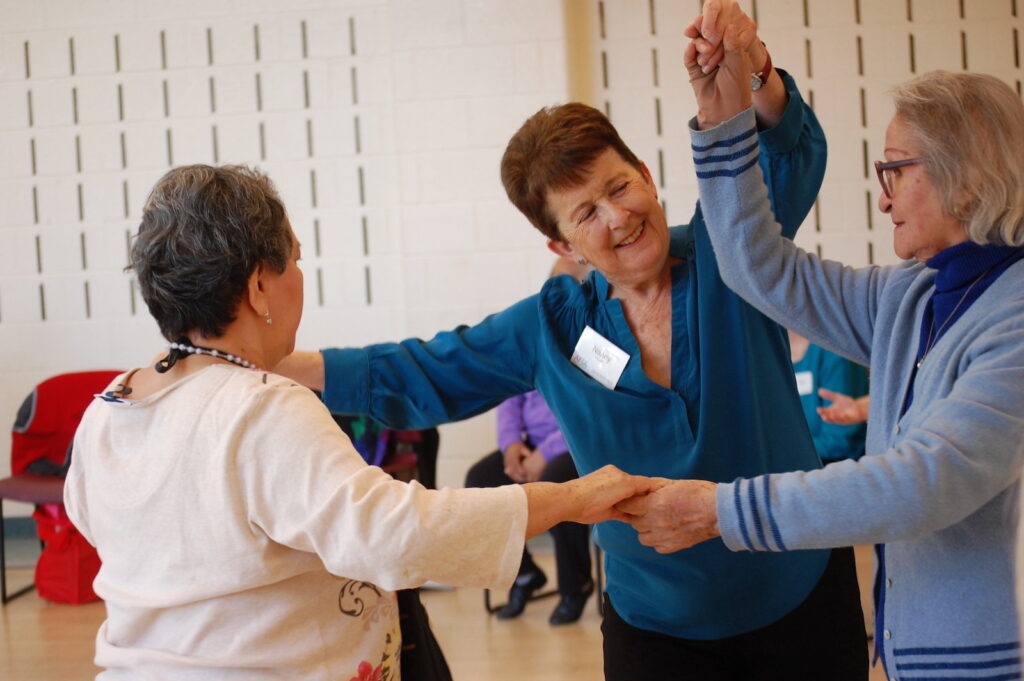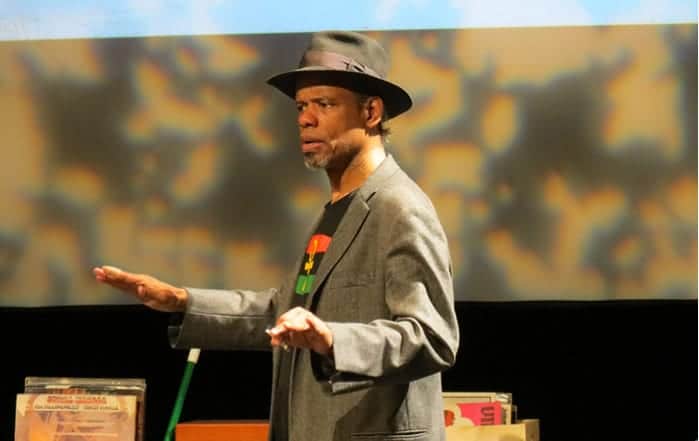by Dylan Klempner
This article was first published The DC Line here.
At a time when the world has been preoccupied with the health of seniors, dancer and choreographer Nancy Havlik has continued teaching an unlikely approach to the physical and mental well-being of people over the age of 65 — dance.
“We were meant to move. It’s part of our DNA,” said Havlik, who has led Quicksilver, a group of improvisational senior dancers, for the past 25 years.
The program is sponsored by Arts for the Aging, a Rockville, Maryland-based nonprofit founded in 1988 by scientist, arts patron and sculptor Lolo Sarnoff that offers multidisciplinary arts programs for seniors with a wide range of physical and cognitive abilities. In addition to Quicksilver’s dance classes, Arts for the Aging also offers storytelling, singing, drawing, painting and photography classes. The organization also employs 25 “teaching artists,” including visual artists who exhibit nationally, opera singers who perform at the Kennedy Center, and professional dancers such as Havlik.
“Everyone has a different entry point to art, and if we can cover a lot of those areas and ways of reaching people, you’re more likely to spark that connection,” program director Sarah House said in a recent interview.
Seniors throughout the Washington area can participate in Arts for the Aging programs — primarily online until a full in-person schedule resumes — through partnering community and residential care settings, including adult day centers, community centers, assisted living communities, nursing homes and senior villages.
In the District these include Iona Senior Services, East River Family Strengthening Collaborative’s Deaf and Hard of Hearing Senior Program, Genevieve N. Johnson Senior Center, and Kingdom Care Senior Village. Other offerings are presented in conjunction with The Phillips Collection and the Smithsonian Institution’s “See Me” program.

Havlik says she happened to launch Quicksilver just as DC-based choreographer Liz Lerman was disbanding Dancers of the Third Age. A number of older dancers from that company joined her group, whose members typically have a weekly rehearsal in addition to their work with seniors. When the pandemic kept participants out of rehearsal spaces and senior centers, a core collection of members continued to meet online.
“[Improvisational dance] is a skill set,” Havlik said. “And you learn it by practicing it together.”
Beginning in March 2021, the members of Quicksilver — vaccinated and wearing masks for the first few sessions — bundled up for outdoor in-person rehearsals on a basketball court at the Chevy Chase Community Center. Occasionally the sessions were displaced by a pickleball group. But Havlik said it was still great to see fellow dancers and share space with them again.
On July 19, Arts for the Aging held its first in-person activity since the start of the pandemic. House, who attended the event at the Genevieve Johnson Senior Center on Blagden Avenue NW, said visual artist Marcie Wolf-Hubbard showed seniors and staff how to use drawing materials to replicate nature-inspired stained glass.
Janine Tursini, Arts for the Aging’s director and CEO, said the organization will continue offering virtual and hybrid options for the time being. Quicksilver began in-person rehearsals (masked and socially distanced) in September, but for safety reasons has not yet facilitated dance workshops with Arts for the Aging’s client sites. Overall, four of the organization’s 24 clients are currently able to host in-person programs.
Research in the field of creative aging suggests regular participation in the arts can have health benefits, according to Tursini. But she is careful to point out that, while the creative activities her artists facilitate can be therapeutic, they should not be considered therapy. Nor are they entertainment, although some may find them entertaining.
“They’re all about participation,” Tursini said. Teaching artists often stand at the center of a circle, encouraging group members “to dance with one another, talk to each other, imagine with each other.”
Arts for the Aging also trains other artists to use their model when working with seniors. When The Washington Chorus contacted Tursini, its singers were already performing in nursing homes and assisted living communities, but the group contracted with Arts for the Aging to help develop performers’ participatory skills.
During the training, Quicksilver dancers divided chorus members into small groups and taught them “movement phrases” that they could do along with their songs. For example, Havlik noticed that the singers were already rocking from side to side while they performed. “You can get your group of frail seniors to rock with you,” she recalled telling the trainees.
The Washington Chorus training was cut short by the pandemic, but the nonprofit plans to continue training artists who wish to work with seniors, in part through a collaboration with the DC Commission on the Arts and Humanities.
Havlik says the trainings help artists feel more confident about working with seniors. “We kind of take what they already have, and just affirm it,” she said.
Improvisational dance is an example of a multidisciplinary art form in which virtually anyone can participate. Focused movement isn’t just for trained dancers or trained athletes, says Havlik. Inviting people who may be inactive — whether due to illness or limited mobility — to move can appear to wake them up. “You see their essence come out,” Havlik said
She recalls seeing the simple gestures of a man taking a class at the Downtown Cluster’s Geriatric Day Care Center before the pandemic. His health had been deteriorating, and he could hardly move. During a dance with Quicksilver, the man began tapping his knee with his fingers.
“And then he had a little shake of his arm. And then his shoulder on the other side would wiggle a little bit,” Havlik said. “It was close to the end of his life, but he was still in the group.”





No Comments